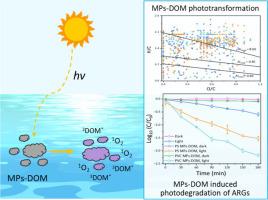Photochemistry of microplastics-derived dissolved organic matter: Reactive species generation and organic pollutant degradation
IF 11.4
1区 环境科学与生态学
Q1 ENGINEERING, ENVIRONMENTAL
引用次数: 0
Abstract
Dissolved organic matter (DOM) originating from microplastics (MPs-DOM) is increasingly recognized as a substantial component of aquatic DOM. The photochemistry of MPs-DOM, essential for understanding its environmental fate and impacts, remains largely unexplored. This study investigates the photochemical behaviors of MPs-DOM derived from two common plastics: polystyrene (PS) and polyvinyl chloride (PVC), which represent aromatic and aliphatic plastics, respectively. Spectral and high-resolution mass spectrometry analyses demonstrated that photoreactions preferentially targeted poly-aromatic compounds within the MPs-DOM, leading to degradation products that predominantly form N-aliphatic/lipid-like substances. This transformation is characterized by decreased aromaticity and unsaturation. Additionally, irradiation of MPs-DOM generated reactive species (RS), including triplet intermediates (3DOM*) and singlet oxygen (1O2), with apparent quantum yields of 0.06–0.16% and 0.16–0.35%, respectively—values considerably lower than those for conventional DOM (1.19–1.56% for 3DOM* and 1.34–1.90% for 1O2). Despite this, the RS generated from MPs-DOM significantly enhance the degradation of coexisting organic pollutants, such as antibiotic resistance genes (ARGs). The findings shed light on the photoinduced transformation of MPs-DOM and suggest that MPs-DOM functions as a natural photocatalyst, mediating redox reactions of pollutants in sunlit aquatic settings. This highlights its previously underestimated role in natural attenuation and aquatic photochemistry.

微塑料衍生溶解有机物的光化学:反应物生成和有机污染物降解
人们日益认识到,源自微塑料的溶解有机物(DOM)是水生 DOM 的重要组成部分。MPs-DOM 的光化学特性对了解其环境归宿和影响至关重要,但在很大程度上仍未得到研究。本研究调查了从聚苯乙烯(PS)和聚氯乙烯(PVC)这两种常见塑料中提取的 MPs-DOM 的光化学行为,这两种塑料分别代表芳香族塑料和脂肪族塑料。光谱和高分辨率质谱分析表明,光反应优先针对 MPs-DOM 中的多芳香族化合物,导致降解产物主要形成 N-脂肪族/类脂物质。这种转变的特点是芳香度和不饱和度降低。此外,辐照 MPs-DOM 还会产生活性物种(RS),包括三重中间体(3DOM*)和单线态氧(1O2),其表观量子产率分别为 0.06-0.16% 和 0.16-0.35% --该数值大大低于常规 DOM(3DOM* 为 1.19-1.56%,1O2 为 1.34-1.90%)。尽管如此,MPs-DOM 产生的 RS 仍能显著提高共存有机污染物(如抗生素抗性基因 (ARG))的降解能力。这些发现揭示了 MPs-DOM 的光诱导转化,并表明 MPs-DOM 具有天然光催化剂的功能,可在阳光照射的水生环境中介导污染物的氧化还原反应。这凸显了它在自然衰减和水生光化学中被低估的作用。
本文章由计算机程序翻译,如有差异,请以英文原文为准。
求助全文
约1分钟内获得全文
求助全文
来源期刊

Water Research
环境科学-工程:环境
CiteScore
20.80
自引率
9.40%
发文量
1307
审稿时长
38 days
期刊介绍:
Water Research, along with its open access companion journal Water Research X, serves as a platform for publishing original research papers covering various aspects of the science and technology related to the anthropogenic water cycle, water quality, and its management worldwide. The audience targeted by the journal comprises biologists, chemical engineers, chemists, civil engineers, environmental engineers, limnologists, and microbiologists. The scope of the journal include:
•Treatment processes for water and wastewaters (municipal, agricultural, industrial, and on-site treatment), including resource recovery and residuals management;
•Urban hydrology including sewer systems, stormwater management, and green infrastructure;
•Drinking water treatment and distribution;
•Potable and non-potable water reuse;
•Sanitation, public health, and risk assessment;
•Anaerobic digestion, solid and hazardous waste management, including source characterization and the effects and control of leachates and gaseous emissions;
•Contaminants (chemical, microbial, anthropogenic particles such as nanoparticles or microplastics) and related water quality sensing, monitoring, fate, and assessment;
•Anthropogenic impacts on inland, tidal, coastal and urban waters, focusing on surface and ground waters, and point and non-point sources of pollution;
•Environmental restoration, linked to surface water, groundwater and groundwater remediation;
•Analysis of the interfaces between sediments and water, and between water and atmosphere, focusing specifically on anthropogenic impacts;
•Mathematical modelling, systems analysis, machine learning, and beneficial use of big data related to the anthropogenic water cycle;
•Socio-economic, policy, and regulations studies.
 求助内容:
求助内容: 应助结果提醒方式:
应助结果提醒方式:


